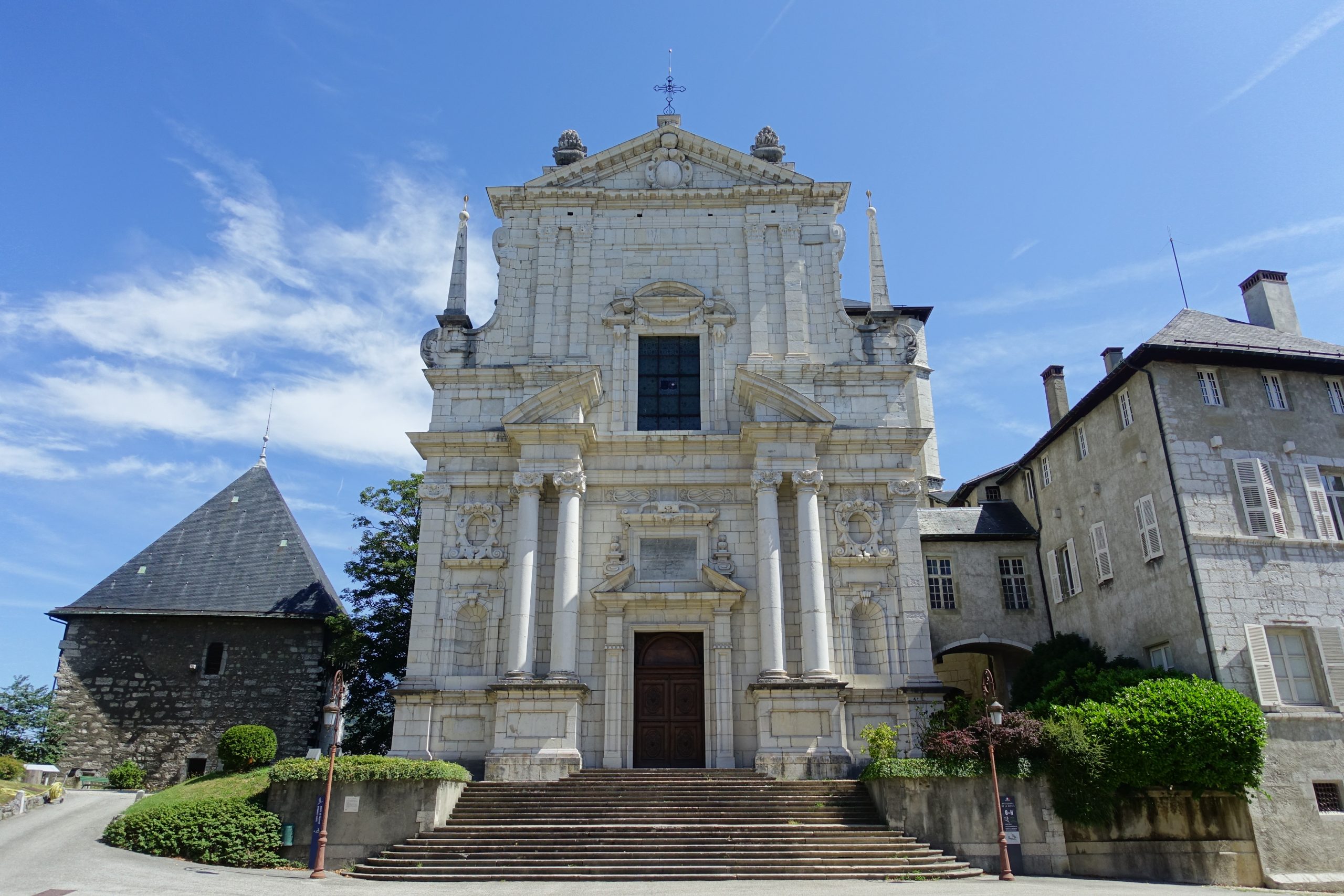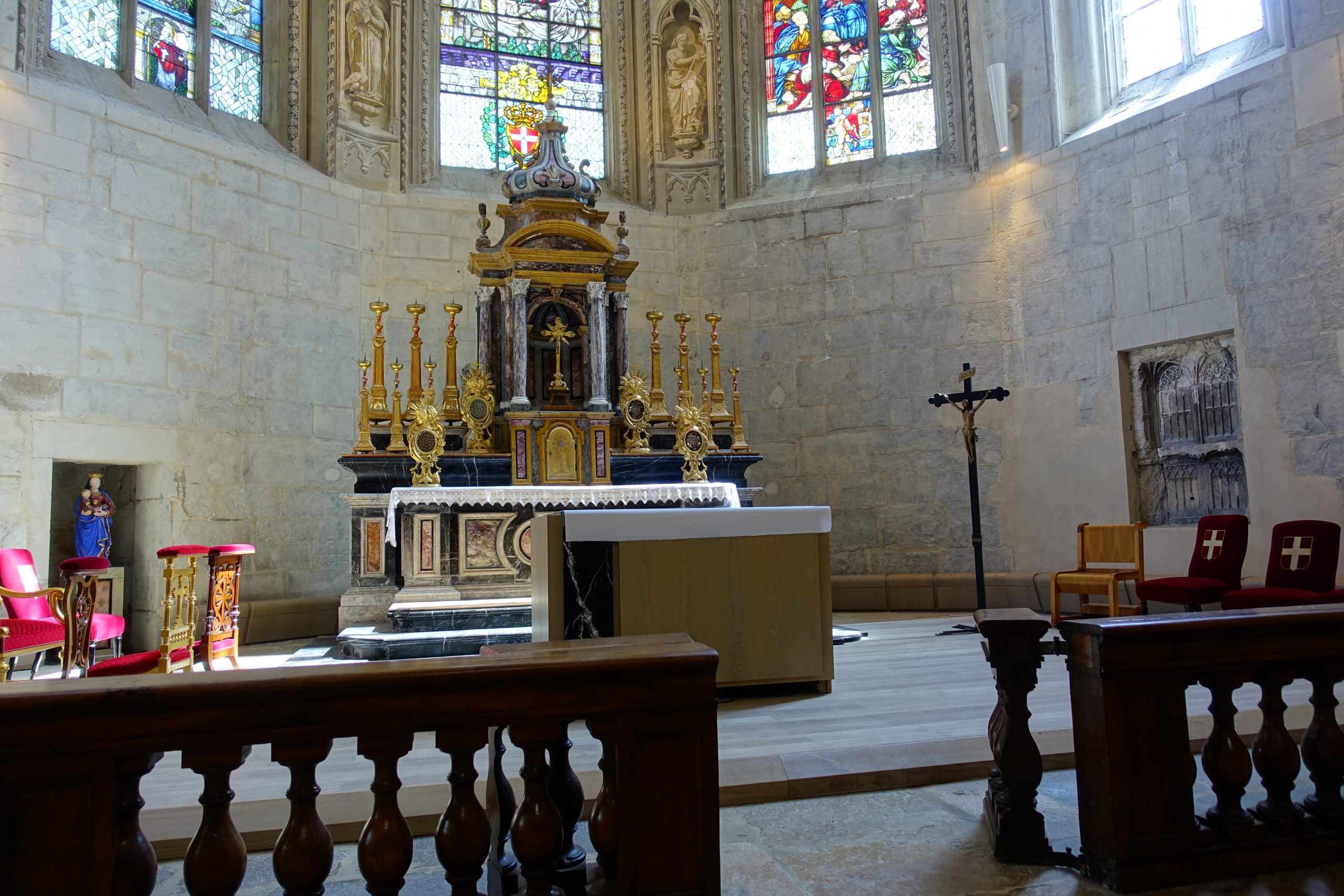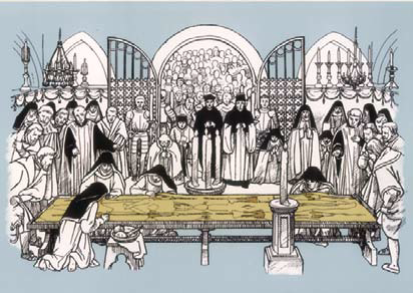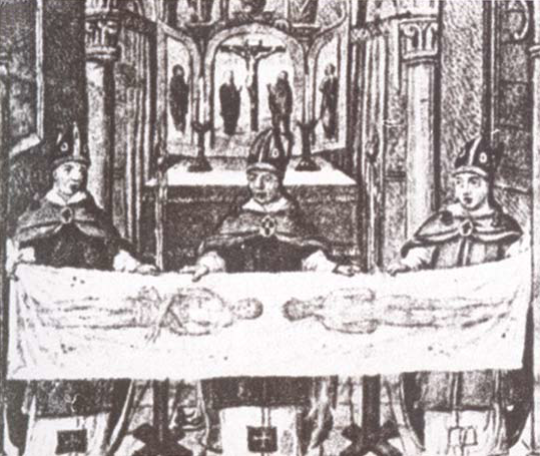The Shroud in the Hands of the House of Savoy
Marcin Grala ![]()
Pontifical University of John Paul II, Kraków, Poland
Determining when exactly the Shroud became the property of the Dukes of Savoy and Piedmont poses difficulties. Margaret de Charny, the previous possessor of the relics, had been seeking to transfer the linen into the right hands since the mid-15th century. The granddaughter of Gotfried I had no children, and, in addition, she had been in litigation for years with the canons of Lirey over the right to dispose of the Shroud. All this made her finally decide to hand over the linen to the House of Savoy, which probably happened on 22 March 1453, when Duke Louis I of Savoy officially granted Margaret the Castle of Varambon and the proceeds of the Miribel estate near Lyon. According to the ducal document, these generous grants were made in gratitude for unspecified “valuable favours.” It is presumed that this bequest was a codeword for an exchange made by Louis I and his wife Anne Lusignan, namely that the aforementioned estates were payment to Margaret for the handing over of the Shroud; such a transaction could not be made officially due to the prohibition on trading in relics.
As Ian Wilson points out, the new owners of the Shroud were distinguished by their piety. Louis I of Savoy was a descendant of Saint Louis, and his father, Amadeus VIII, became a clergyman during his widowhood, whom the Council of Basel proclaimed pope in 1439 (antipope Felix V, 1439–1499). Louis and Anne surrounded the relics they had acquired from Margaret de Charny with great veneration. Very soon the Shroud began to be treated as a dynastic palladium. This attitude to the cloth with the image of Christ may have been influenced by Anna Lusignan, who came from Cyprus. It is likely that in her homeland she watched as Eastern Rite Christians celebrated the bringing of the Mandylion to Constantinople every 16 August. When the Shroud became a dynastic palladium, it was no longer displayed in public. The relic accompanied the princely family on numerous journeys. When the court returned to its seat in Chambéry, the linen was deposited in the local Franciscan church.
Rome voiced its strong opinion about the Shroud precisely at a time when, in the first years after its acquisition by the House of Savoy, it had become a private relic of the family and was not on public display. There is no indication that Rome’s reaction was the reason for the solicitations on the part of the dukes of Savoy and Piedmont; rather, the fact that the dynasty had close links with the Franciscan Order and that the Shroud was temporarily kept in their monastery was significant. In the second half of the 15th century, the Church was in the midst of a theological dispute over the essence and significance of the Blood of Christ, in which the Franciscan theologian Francesco Della Rovere played an important role. On the occasion of these disputes, the clergyman wrote a treatise “De sanguine Christi” in 1464, in which he mentioned that in the hands of the House of Savoy there was a Shroud stained with the blood of Christ. At the same time, he pointed out that this was the linen in which the Saviour’s body was wrapped after being taken down from the cross. A few years later, this Franciscan was elected pope (Sixtus IV) and his work was published in print. Opinions on the authenticity of the relic, which was in the possession of the House of Savoy, were thus indirectly confirmed by the authority of the Holy See.


Subsequent decisions by successive popes show that they were convinced of the uniqueness of the relic kept at Chambéry. Amadeus IX, son and successor of Louis I, began to rebuild the château chapel, where the Shroud was to be kept. Before the construction was completed, in 1467 Pope Paul II elevated the chapel to the status of a collegiate church. The reconstruction was completed in 1502 and the Shroud was then solemnly transferred to the new tabernacle, which from 1506 onwards, with the approval of Julius II, began to be called the “Holy Chapel” (French: la Sainte-Chapelle de Chambéry). The Pope issued a bull establishing 4 May as the Feast of the Shroud, which spread the fame of the relic and led the Savoy court to decide to display it publicly. Adorations were organised regularly in Chambéry, as well as in other areas of Savoy, where many pilgrims came. News of the extraordinary relic attracted King François I of France to the Shroud’s place of safekeeping in Chambéry twice, in 1511 and 1516.
The Shroud—venerated, carefully guarded and stored in a new silver reliquary funded by Margaret of Habsburg in 1509—was partially destroyed in 1532. On the night of 3 to 4 December, a fire broke out in the sacristy of la Sainte-Chapelle de Chambéry. The box containing the folded linen was brought out of the flames at the last moment, just as its casing was beginning to catch fire. The melting metal burned holes in the Shroud, while the water used to extinguish the fire left stains that are still visible today.

The painstaking work of restoring the monument was entrusted to the Poor Clares of Chambéry, who in April and May 1534 sewed patches cut from the altar cloth onto the Shroud and lined the whole fabric with fine Dutch linen. These measures allowed the Shroud to continue to be displayed, which contradicted rumours that it had not survived the fire.
From the beginning of the 16th century, when Charles III the Good took power in the Duchy of Savoy, the monarchy found itself in a difficult international situation. Particularly dangerous was the pressure from France, which sought to occupy as much of the Savoy domain as possible (the Italian Wars). When French troops entered the lands under Charles III’s rule in 1535, the decision was made to transport the Shroud to Turin and then to Milan. As the unrest continued, the relic was moved to the former Vercelli and also to Nice.
It was only in 1561 that the Shroud was returned to la Sainte-Chapelle de Chambéry. It was then that the townspeople were able to see the linen after a 25-year interval. Many years of wars had made the former seat of the House of Savoy unsuitable as a political centre and residence for the court. After some thought, in 1563 the new ruler, Emmanuel Philibert, moved the capital of the duchy to Turin.

This entailed the transfer of the Shroud from Chambéry to Turin. This was done when Duke Emmanuel Philibert learned of the planned pilgrimage of the Archbishop of Milan, Cardinal →Charles Borromeo, who wished to visit Chambéry to adore the extraordinary image of Christ. It was at this time that it was decided to transport the Shroud to Turin, thus shortening the pilgrimage of the ailing hierarch. The famous linen was solemnly welcomed in Turin on 14 September 1578. From then on, this city became the next and, so far, the last place where the Shroud was kept. Initially, the Shroud was placed in the ducal chapel of the Church of St Lawrence and later in the Cathedral. Due to the great interest, the display of the relic was organised every 4 May, usually placing it on a specially prepared platform in the square in front of the Palazzo Madama. From the end of the 16th century, the fame of the Shroud drew crowds to Turin; among the more famous pilgrims, in addition to the aforementioned Charles Borromeo, were St Francis de Sales and St Jeanne de Chantal. In 1670, the Roman Congregation for Indulgences decided that visitors to Turin for adoration of the Shroud were granted a plenary indulgence, with the church authorities remaining reticent in assessing the authenticity of the relics. The congregation stated that spiritual graces were received by those pilgrims who came to Turin not to venerate the linen as the real Shroud of Christ, but rather to meditate in their hearts on his Passion, especially his death and entombment (quoted after Wilson 1983, p. 262).
Despite the fact that the Holy See had not settled the question of the Shroud’s authenticity, a large number of pilgrims kept coming to Turin and successive representatives of the House of Savoy made efforts to honour the relic properly. From the mid-17th century, efforts were made to build a chapel to house the famous cloth. During the reign of Charles Emmanuel II, in 1649, Bernardino Quadri, known for his work on the Basilica of St John Lateran and his collaboration with Giovanni Lorenzo Bernini, came to Turin. The architect’s task was to prepare a design for the enlargement of Turin Cathedral to create a more impressive place for the storage of the Shroud. His design was based on an earlier idea by Carlo di Castellamonte and envisaged the construction of an oval chapel behind the choir. Quadri was unable to complete the work he had undertaken; from 1667 onwards, it was carried out by another architect, Guarino Guarini, a member of the order of the Theatines. He designed a room that was placed between the palace and the cathedral to provide the princes with unrestricted access to the Shroud. The project was not completed until 1694, during the reign of Marie Joanna of Savoy, widow of Charles Emmanuel II. On the occasion of the relic’s transfer to the new chapel, which was named the Cappella della Sacra Sindone, the linen underwent further restoration consisting mainly of corrections to the work carried out in 1534 by the Poor Clares. Prince Victor Amadeus II, together with his confessor and great venerator of the Shroud, Sebastian Valfrè (beatified in 1834), and the Duchess Anne of Orléans, took part in this work.
With the advent of the 18th century, the frequency of public presentations of the Shroud declined. This was due to growing concerns about the state of the linen, the difficult political situation of the Duchy of Savoy (e.g. in 1706, when Turin was about to be besieged by French troops, the Shroud was taken to Genoa for a while) and the dominance of Enlightenment currents, which approached religious issues with a great deal of scepticism. The fact that the mood was not in favour of such relics is best demonstrated by the fate of a copy of the Turin Shroud, the so-called Shroud of Besançon, which was destroyed during the French Revolution. In 1750, the Shroud was presented on the occasion of the marriage of Victor Amadeus III to Marie Ferdinand and from then on, the relic was only shown in public on the occasion of more important events in the life of the dynasty, the region or the Church. In the 19th century the Shroud was exhibited only five times: in 1804, when Pope Pius VII arrived in Turin; in 1815, on the occasion of the Pope’s release after Napoleon’s defeats; in 1842, to celebrate the wedding of Victor Emmanuel II; in 1868, after Princess Clotilde of Savoy had the linen strengthened by having it lined it with red silk; and in 1898, on the occasion of the 50th anniversary of the first major attempt to establish the Kingdom of Italy, which was made under Charles Albert. During the latter show, the Italian lawyer and amateur photographer Secondo Pia took the first photograph of the Shroud and discovered the negative image of Christ placed on the cloth.
The astonishing effect of the first photograph of the Shroud greatly revived interest in this unusual object. Questions were raised anew about the authenticity of the linen with the image of Christ. Discussions on the subject were particularly lively in Italy and France. The scientific world along with public opinion was divided between those believing in the relic’s authenticity and those convinced that it was a mystification. One of the most important sceptics at the time was the French church historian and archivist Ulysse Chevalier, who between 1899 and 1903 published a number of works attempting to prove that the Shroud was a forgery fabricated in the 14th century. However, some contemporary scholars, including Emmanuel Poulle, point to technical errors allegedly committed by Chevalier in his publications. Apart from this, when analysing the problem of the Shroud’s authenticity, the French clergyman only focused on historical issues, completely ignoring the intriguing mystery of the image that emerged from the negatives made by S. Pia. Also Yves Delage, a French zoologist, professor of comparative anatomy, director of the Museum of Natural History in Paris and member of the Academy of Sciences, addressed this problem. The researcher, although he was an agnostic and did not conceal his anti-clerical views, after a thorough analysis of the Shroud came to the conviction that it was the authentic burial cloth of Christ. The results of his observations Y. Delage presented on 21 April 1902 in a special report delivered before the French Academy. His lecture sparked serious discussion, and the arguments cited by the speaker’s supporters and opponents called for further research. Despite numerous efforts, Y. Delage did not receive permission from the owners of the Shroud to carry out the relevant scientific work. Although the representatives of the House of Savoy denied many scholars access to the relics, the interest of individual researchers from increasingly different scientific fields continued to grow.
From 3 to 24 May 1931, on the occasion of the marriage of Humberto II to Maria Joseph of Belgium, another public exhibition of the Shroud was organised in Turin. At that time, permission to photograph the linen was given to professional photographer Giuseppe Enrie, who, with a better camera than that of S. Pia, took a series of photographs showing even more clearly the image of the figure visible on the Shroud. In May 1931, the prelate Giovanni Battista Montini, the future Pope Paul VI, who worked for the papal diplomacy, had the opportunity to see the relic on public display. Years later he recalled how deeply and profoundly he had been impressed by the adoration of the Shroud (→Popes before the Shroud). Another opportunity to see the famous cloth was given to pilgrims in 1933, the year Pius XI declared the Jubilee of Redemption. The aforementioned Pope held the Shroud in high esteem and was eager to distribute to the faithful pictures depicting the Face of Christ from the Turin cloth. Pius XII had an equally positive attitude towards the relic, calling it a holy thing and unlike anything else (Allen, Pope Francis…), and referring to Turin as a city guarding the precious treasure—the Holy Shroud (The Popes and the Holy…).
Despite the fact that the members of the House of Savoy did not give scholars the opportunity to study the Shroud freely, the scientific world continued to take an interest in the mysterious object from the Cappella della Sacra Sindone. The French doctor of medical sciences, Paul Vignon, tried to explain the process of the creation of the image on the linen and formulated a theory indicating the possibility of biological-chemical processes resulting in the secretion from the dead and tormented body of the substances that produced the image on the linen. At the same time, the anatomical issues of the figures from the Shroud were being investigated by the French physician and surgeon Pierre Barbet. The atmosphere of scientific inquiry related to the Shroud led to the first syndonological scientific conference in Turin in the summer of 1939. The II World War halted the nascent initiative for integrated and interdisciplinary research on the Shroud and set its owners the task of saving the famous linen from destruction.
As Turin, a major industrial centre, was a city vulnerable to bombardment, members of the House of Savoy decided as early as September 1939 to relocate the Shroud. There is a hypothesis that there was also a fear that the German Nazis would requisition the famous linen, which they reportedly inquired about during Hitler’s visit to Italy in 1938. Initially it was planned to transport the relics to the Monte Cassino monastery, but finally the Shroud was hidden in another Benedictine monastery: in Montevergine near Avellino. The Shroud was taken out of Turin on 25 September 1939 and, after a brief stopover in Rome, was hidden in the abbey near Naples in the greatest secrecy, with only four local monks informed.
The Shroud was returned to Turin at the end of October 1946. The transport of the linen to Piedmont was supervised by the Archbishop of Turin, Cardinal Maurilio Fossati. In the post-war period, the relic was subjected to successive examinations increasing our knowledge of this extraordinary object. Among the numerous scientific procedures, a special place is occupied by the analyses that were carried out with the approval of King Humbert II and the ecclesiastical authorities in October 1978 as part of the work of a special project called the Shroud of Turin Research Project (→STURP).
After the II World War, Italy held a referendum in which a large part of the population voted for the country to become a republic. The new ruler, the aforementioned Humbert II, had to abdicate and went into exile. The monarch died on 18 March 1983 in Geneva. According to his will, the Shroud became the property of the Holy See.
References
Allen Jr. J.L., Pope Francis and the Shroud of Turin, “National Catholic Reporter” 2013, 1 April, [on-line:] https://www.ncronline.org/blogs/ncr-today/pope-francis-and-shroud-turin – 29 VI 2022.
Cozzo P., La Sindone e i Savoia, Torino 2015.
Fossati L., The Donation of the Shroud to the Holy See, “Collegamento pro Sindone” 1996, November/December, [on-line:] http://www.sindone.info/CPSWEB2.HTM – 4 VII 2022.
Frale B., Całun Jezusa Nazarejczyka, przekł. G. Rawski, Kraków 2012.
Gierowski J.A., Historia Włoch, Wrocław 1986.
Górny G., Kasprzycki-Rosikoń J., Świadkowie tajemnicy. Śledztwo w sprawie relikwii Chrystusowych, Warszawa–Izabelin 2012.
Marinelli E., The Shroud Chapel Is Three Hundred Years Old, “Collegamento pro Sindone” 1994, September/October, [on-line:] http://www.sindone.info/CPSWEB2.HTM – 4 VII 2022.
Marino J.G., The House of Savoy and Roman Catholic Devotion to the Shroud of Turin, [on-line:] https://www.academia.edu/51155842/The_House_of_Savoy_and_Roman_Catholic_Devotion_to_the_Shroud_of_Turin – 4 VII 2022.
Marion A., Courage A.L., Całun Turyński. Nowe odkrycia nauki, tłum. P. Murzański, Kraków 2000.
Nicolotti A., The Acquisition of the Shroud by the House of Savoy: Documentary Evidence, [in:] The Shroud at Court: History, Usages, Places and Images of a Dynastic Relic, ed. P. Cozzo, A. Merlotti, A. Nicolotti, Leiden–Boston 2019, pp. 20–56, https://doi.org/10.1163/9789004390508_004.
Nicolotti A., Marguerite de Charny, François de La Palud e Ludovico di Savoia: due documenti inediti, “Bollettino storico–bibliografico subalpino” 2018, Anno 116, sem. 1, pp. 191–209.
Nicolotti A., I Savoia e la Sindone di Cristo: aspetti politici e propagandistici, [in:] Cristo e il potere. Teologia, antropologia e politica, a cura di L. Andreani, A.P. Bagliani, Firenze 2017, pp. 247–281.
Panic I., Tajemnica Całunu, Kraków 2010.
Perret A., La Sainte chapelle du château ducal de Chambéry, Lyon 1967.
The Popes and the Holy Shroud: The Long and Silent Prayers of the Popes of Recent Times, “La Stampa” 2015, 19 Aprile, [on-line:] https://www.lastampa.it/vatican-insider/en/2015/04/19/news/the-popes-and-the-holy-shroud-1.35274250 – 29 VI 2022.
Savio P., Pellegrinaggio di San Carlo Borromeo alla Sindone in Torino, “Aevum” 1933, Anno 7, Fasc. 4, pp. 423–454, https://www.jstor.org/stable/25818703.
Saxer V., Le Suaire de Turin aux prises avec l’historie, “Revue d’histoire de l’Église de France” 1990, Vol. 76, No. 196, pp. 21–55, https://doi.org/10.3406/rhef.1990.3483.
The Shroud of Turin: Perspectives on a Multifaceted Enigma: Proceedings of the 2008 Columbus International Conference, August 14–17, 2008, ed. by G. Fanti, Padova 2009.
Waliszewski S., Całun Turyński dzisiaj, Kraków 1987.
Wilson I., Całun Turyński, tłum. A Polkowski, Warszawa 1983.
Wise A., Italian Monks Reportedly Hid The Holy Shroud From Hitler, “abcNews” 2010, 8 April, [on-line:] https://abcnews.go.com/International/italian-monks-reportedly-hid-holy-shroud-hitler/story?id=10320593 – 29 VI 2022.
Whiting B., The Shroud Story, Strathfield 2006.
Zaccone G.M., La Sindone. Una storia nella storia, Turin 2015.
Sources of Images
1. and 2. Château des Ducs de Savoie, https://www.flickr.com/photos/o_0/albums/72157710055275262 (Guilhem Vellut, CC BY 2.0)
3. and 4. Kim jest Człowiek z Całunu? [exhibition brochure], Kraków 2012
